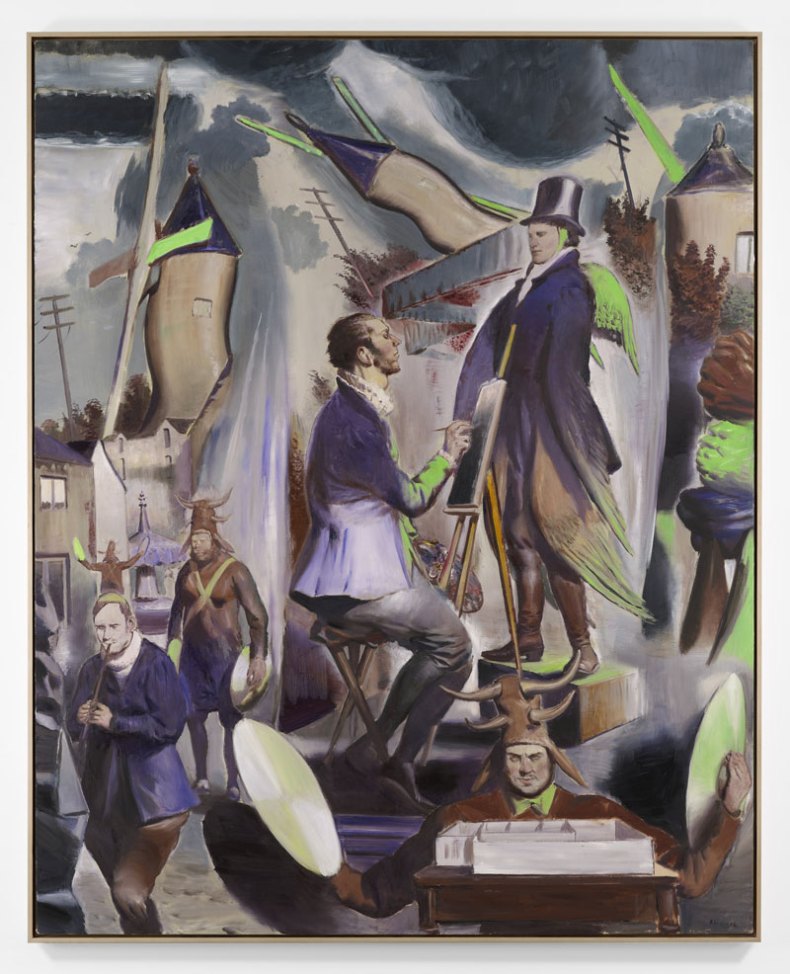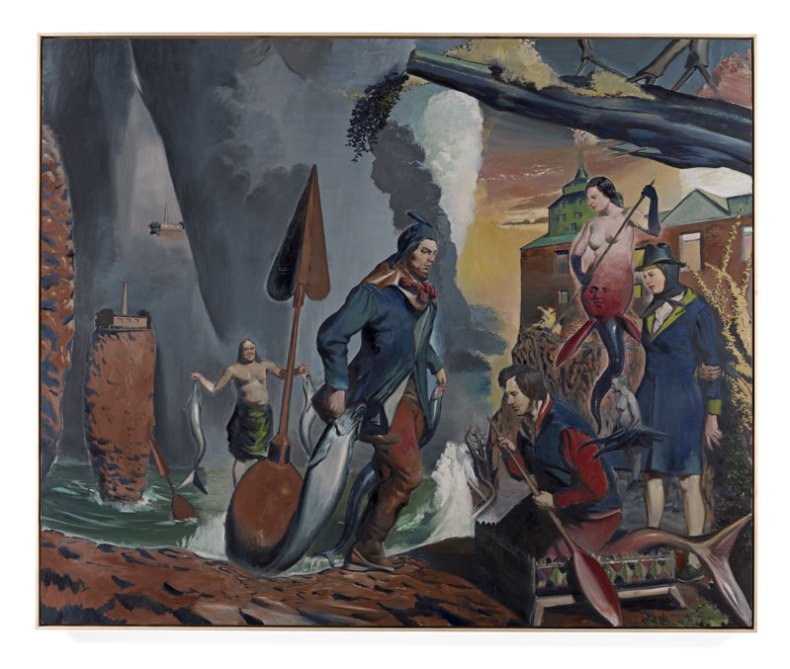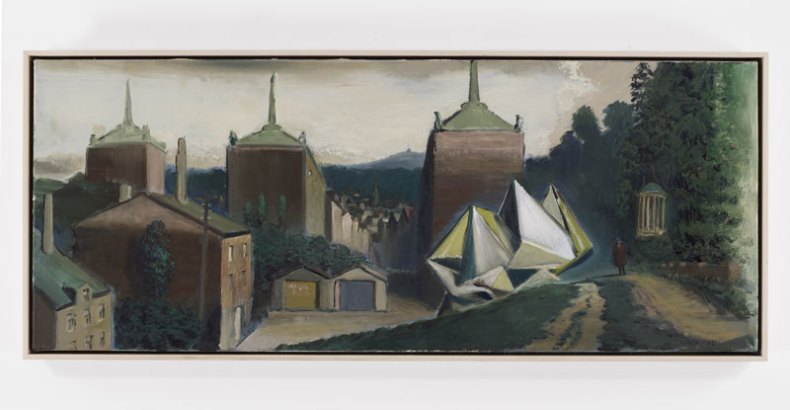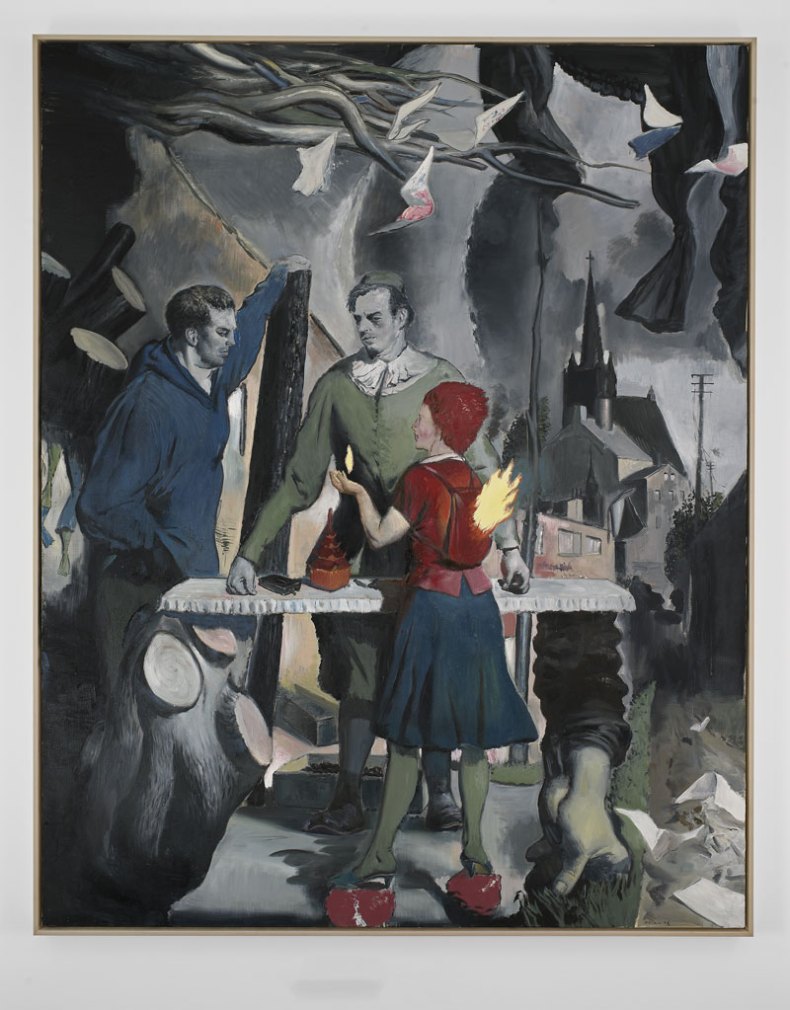Earlier this year I visited ‘s-Hertogenbosch in the Netherlands to see the town’s landmark exhibition about its most famous resident – the wonderfully inexplicable Hieronymus Bosch. On our way into town I found myself caught up in a seemingly directionless procession of people sporting braided military-style jackets with toy frogs stitched on. Small marching bands, with instruments decorated to resemble animals, led clusters of revellers on separate and occasionally intersecting routes, and a crowd gathered nonchalantly in the main square to observe a house that had recently collapsed; its sagging remains lay abandoned behind hastily erected hoardings. Ducking into a café, a local man with a papier-mâché model of ET provided something by way of explanation. Mardi Gras had been impossible the previous month due to bad weather, so the residents, unwilling to abandon their plans, rescheduled. I had unwittingly crashed the party.

Der Auftakt (2016), Neo Rauch Courtesy David Zwirner, New York/London
I bring this all up because, standing in front of one of the Leipzig-based painter Neo Rauch’s recent canvases in David Zwirner’s London gallery last week, I felt momentarily transported back. It was the sight of a man (or a woman – the figure’s head is obscured) standing in a European street in a headless ostrich costume that did it. The figure appears in Die Forderung, next to the flattened apparition of a faceless woman leaning on a shop window like a cardboard cut-out. Elsewhere in the composition, two men dance with what look like coatings of clay or tar covering their hands. In another work, a man in a horned hat bashes cymbals together as he drifts down a street, accompanied by a rather sorrowful-looking piper. Each of the paintings on display brings together a similarly bizarre cast of costumes and characters, with no discernable explanation – or at least, no rational one.

Der Fischzug (2016), Neo Rauch. Courtesy David Zwirner, New York/London
What Rauch captures in his canvases is that sense of unanchored strangeness that comes from finding yourself in a social situation or community whose traditions and rituals you are not privy to. Of course, Rauch’s creations are surreal in a far more literal sense than any carnival can be. They are impossible scenes, peopled with hybrids and monsters as well as the more believable figures. Their relationships to each other are obscure or non-existent. Each work is also subject to bewildering and undisguised distortions of space, time and perspective – windmills wobble in the breeze, industrial buildings take off into the sky, streets open out of nowhere and giants patrol the horizons – as if the various events depicted are taking place on different planes of existence. In this sense they are clearly reminiscent of Bosch’s work, which famously present visions of the afterlife that are unconstrained by physics and other worldly mundanities. Some of the characters – such as the floating merwoman with a spear in Der Fischzug – could come directly from Bosch, but that inviting comparison overlooks the sheer range of historical and contemporary art from which Rauch actually draws.

Das Privatmuseum (2016), Neo Rauch. Courtesy David Zwirner, New York/London
The weird mixture of architecture in each piece (most notably in Das Privatmuseum, which contrasts a jagged modern pavilion with brick industrial buildings and a classical folly) is reminiscent of the imaginative settings of early Renaissance paintings. The musicians in Tief im Holz could have wandered out of a Dutch genre scene, while the landscapes beneath them form a mysterious sort of predella. In Der Auftakt, an artist in a ruff sits down to paint a man in a suit and top hat, who has sprouted a fetching set of wings. He puffs out his chest in what strikes me as a parody of traditional western portraiture, with its props and costumes and awkward commitment to stiff poses. There’s a pair of seemingly modernist sculptures in Skulpturengarten, and the girl proffering a floating lick of flame in Das Angebot looks like a cousin to the strange figures in the recent work of Rauch’s contemporary Michael Börremans. This is an uprooted reunion of everything strange in the supposedly familiar tale of western art history – a reaction, one assumes, against the oppressive, proscriptive Socialist realism that dominated in the Eastern Bloc during Rauch’s youth.

Das Angebot (2016), Neo Rauch. Courtesy David Zwirner, New York/London
Rauch has always been up to the challenge implicit in his quotations from the Old (and new) Masters. His painting is full of confidence, and his ability to conjure up vivid details in a few quick strokes is striking – it’s particularly evident in the rough but believably characterised faces. If the artist were to pick any one of the individual passages in his compositions (the landscapes, the street scenes, the portraits), and tidy them up in isolation, they’d be impressive examples of their genres. But he doesn’t. Every passage seems unfinished, abandoned, scruffy – but it is precisely this raggedness around the edges that allows him to knit the parts together into a strangely convincing whole. It also gives these works a tremendous sense of provisional energy, as if the artist might come back in at any minute to conjure a new character from the barely-dried paint (the smell of oils permeates the gallery). In Rauch’s work, the mysteries of painting are left deliberately, tantalisingly, unresolved.
‘Neo Rauch: Rondo’ is at David Zwirner, London, until 12 November.














![Masterpiece [Re]discovery 2022. Photo: Ben Fisher Photography, courtesy of Masterpiece London](http://zephr.apollo-magazine.com/wp-content/uploads/2022/07/MPL2022_4263.jpg)
Suzanne Valadon’s shifting gaze